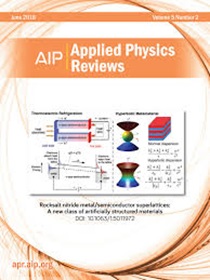Superior self-powered infrared photodetector via semiconducting graphene-nanoribbons-based vertical heterojunctions
IF 11.6
1区 物理与天体物理
Q1 PHYSICS, APPLIED
引用次数: 0
Abstract
Self-powered photodetectors, operating without an external power source, have garnered extensive interest for infrared (IR) detection owing to their vast potential in low-power consumption sensor systems. Here, a short-wavelength infrared (SWIR) heterojunction photodetector utilizing semiconducting graphene nanoribbons has been achieved and demonstrated record-high performance. In the self-powered mode, the heterojunction photodetector presents a responsivity of 73.5 A/W and a detectivity of 7.5 × 1014 Jones, surpassing previously reported self-powered IR photodetectors by several orders of magnitude. The superior performance is primarily due to the enhancement of the electric field caused by the photogating effect at the heterointerface. The device also displays unparalleled performance at −5 V bias voltage, achieving a responsivity of 843 A/W, a detectivity of 1015 Jones, and an external quantum efficiency of 105%, all of which are record-breaking values for SWIR photodetectors to date. Therefore, our approach provides new insight and demonstrates great potential for future high-performance low-power consumption IR detection technology.基于半导体石墨烯-纳米带垂直异质结的高性能自供电红外探测器
由于其在低功耗传感器系统中的巨大潜力,无需外部电源即可工作的自供电光电探测器在红外探测领域获得了广泛的兴趣。在这里,利用半导体石墨烯纳米带实现了短波长红外(SWIR)异质结光电探测器,并展示了创纪录的高性能。在自供电模式下,异质结光电探测器的响应率为73.5 a /W,探测率为7.5 × 1014 Jones,比先前报道的自供电红外光电探测器高出几个数量级。这种优越的性能主要是由于异质界面处的光控效应引起的电场增强。该器件在- 5 V偏置电压下也显示出无与伦比的性能,实现了843 a /W的响应率,1015 Jones的探测率和105%的外部量子效率,这些都是迄今为止SWIR光电探测器的破纪录值。因此,我们的方法提供了新的见解,并展示了未来高性能低功耗红外探测技术的巨大潜力。
本文章由计算机程序翻译,如有差异,请以英文原文为准。
求助全文
约1分钟内获得全文
求助全文
来源期刊

Applied physics reviews
PHYSICS, APPLIED-
CiteScore
22.50
自引率
2.00%
发文量
113
审稿时长
2 months
期刊介绍:
Applied Physics Reviews (APR) is a journal featuring articles on critical topics in experimental or theoretical research in applied physics and applications of physics to other scientific and engineering branches. The publication includes two main types of articles:
Original Research: These articles report on high-quality, novel research studies that are of significant interest to the applied physics community.
Reviews: Review articles in APR can either be authoritative and comprehensive assessments of established areas of applied physics or short, timely reviews of recent advances in established fields or emerging areas of applied physics.
 求助内容:
求助内容: 应助结果提醒方式:
应助结果提醒方式:


